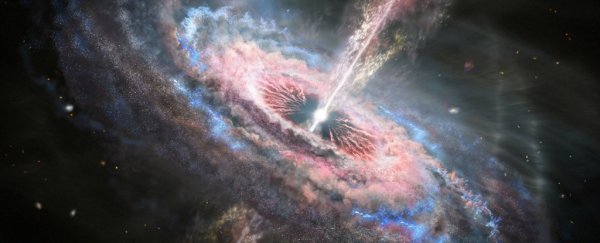It's well known that quasars are the most luminous galaxies in the Universe, spewing insane amounts of radiation across space as their supermassive black holes rapaciously devour material from a colossal accretion disc.
Well, they just got even more hardcore. Astronomers have discovered that blasts of radiation emanating from quasars can act like a tsunami as they spread through the surrounding galaxy, pushing material outward at velocities approaching a few percent of light speed.
Such blasts of radiation are already known to move particles to a fraction of the speed of light, but these new discoveries take it to another level, with some of the fastest jumps in velocity seen to date.
What's more, as they blast through the material in their home galaxies, they quench the formation of new stars.
"These outflows are crucial for the understanding of galaxies' formation," said astrophysicist Nahum Arav of Virginia Tech.
"They are pushing hundreds of solar masses of material each year. The amount of mechanical energy that these outflows carry is up to several hundreds of times higher than the luminosity of the entire Milky Way galaxy."
The quasar stage of a galaxy's life is usually very early on – a period of intense activity that lasts up to a few billion years before the black hole settles down into a more conventional adulthood, having consumed or blown away all the nearby matter.
We know that this black hole activity generates powerful winds that blow into the surrounding space. We also know that the cold gas in this space is the stuff from which stars are formed. It's thought that when the black hole wind pushes it away, since there's nothing left to form stars, star formation is quenched.
This is consistent with what we have observed in older galaxies, which are much quieter than those hosting quasars; in fact, exactly how star formation is quenched is a puzzle astronomers have been trying to solve for a long time, since without it, the Universe would probably look very different from the one we see, with bigger galaxies and considerably more stars.
It's possible there are multiple mechanisms that can explain this ongoing puzzle.
"Both theoreticians and observers have known for decades that there is some physical process that shuts off star formation in massive galaxies, but the nature of that process has been a mystery," explained cosmologist Jeremiah Ostriker of Columbia University and Princeton University.
"Putting the observed outflows into our simulations solves these outstanding problems in galactic evolution."
Arav and his team studied Hubble observations of 13 known quasars to look for outflows. As these quasar tsunamis collide with interstellar gas, the collision generates intense heat, the energy of which is emitted in the form of light across the electromagnetic spectrum.
"You'll get lots of radiation first in X-rays and gamma rays, and afterwards it will percolate to visible and infrared light," Arav said. "You'd get a huge light show, like Christmas trees all over the galaxy."
From this data, they were able to measure the three most energetic quasar outflows seen to date, found in quasar galaxies SDSS J1042+1646, SDSS J0755+2306, and 2MASS J1051+1247. All three were powerful enough to produce the feedback required for galactic quenching.
Among these, SDSS J1042+1646 was a record-breaker, exhibiting the most rapidly accelerating outflow. In a three-year period, one of its outflows accelerated from 70 million kilometres per hour (43 million mph) to 74 million kilometres per hour (46 million mph).
This research doesn't just show how galaxies can be quenched, though. It could also be a very neat explanation for why the size of most galaxies correlates with the size of their black hole.
If the black hole is blowing material away, it's not just limiting how many stars can form; it's also limiting the material it can feed on, and therefore how big it can grow.
"Hubble's ultraviolet observations allow us to follow the whole range of energy output from quasars, from cooler gas to the extremely hot, highly ionised gas in the more massive winds," said astronomer Gerard Kriss of the Space Telescope Science Institute.
"These were previously only visible with much more difficult X-ray observations. Such powerful outflows may yield new insights into the link between the growth of a central supermassive black hole and the development of its entire host galaxy."
The research has been published in six papers in The Astrophysical Journal Supplement Series.
